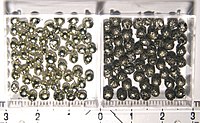
Photo from wikipedia
Liquid-state interfacial reactions of p-type (Bi,Sb)2Te3 thermoelectric (TE) material with Sn and Sn-3.0 wt.%Ag-0.5 wt.%Cu (SAC305) solders, respectively, were examined at 250°C on a commercial highly orientated (Bi,Sb)2Te3 substrate with a (110)… Click to show full abstract
Liquid-state interfacial reactions of p-type (Bi,Sb)2Te3 thermoelectric (TE) material with Sn and Sn-3.0 wt.%Ag-0.5 wt.%Cu (SAC305) solders, respectively, were examined at 250°C on a commercial highly orientated (Bi,Sb)2Te3 substrate with a (110) soldering plane. For the reactions with Sn, the initial reaction phase was the porous SnTe intermetallic compound (IMC). Then, a dense SnTe layer with many tiny cracks formed between the porous phase and TE substrate. With longer aging time, the dense SnTe gradually changed to the porous phase due to Sb dissolution. In the subsequent stage, the reaction phase zone included porous SnTe, an alternating layer microstructure of SnTe and liquid solder, and SnTe/Sn3Sb2 alternating layers from the solder to TE. The IMC growth was extremely fast, being approximately 15 μm/min, and nearly linear with aging time, suggesting reaction control. For the reactions with SAC305, a similar microstructure of porous SnTe and the dense layer was observed. Compared with the reactions with Sn, however, the IMC growth rate was greatly suppressed by ~ 80%. This can be attributed to the Ag-rich phase layer between the dense SnTe and (Bi,Sb)2Te3. Ag was verified to be the key element for dramatically changing the interfacial reaction behavior.
Journal Title: JOM
Year Published: 2020
Link to full text (if available)
Share on Social Media: Sign Up to like & get
recommendations!